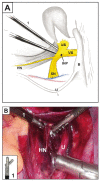The Diagnosis of Perineural Invasion: A Crucial Factor in Novel Algorithm of Coexistence of Conventional and Nerve-Sparing Radical Hysterectomy
- PMID: 34441243
- PMCID: PMC8391994
- DOI: 10.3390/diagnostics11081308
The Diagnosis of Perineural Invasion: A Crucial Factor in Novel Algorithm of Coexistence of Conventional and Nerve-Sparing Radical Hysterectomy
Abstract
Nerve-sparing radical hysterectomy (NSRH) was introduced to mitigate adverse effects associated with conventional radical hysterectomy (CRH) in cervical cancer. However, the introduction of NSRH was compromised by possible existence of perineural invasion (PNI). Additionally, the coexistence of NSRH and CRH is currently the fact. The aim of the study was to review the literature and attempt to construct a novel and preliminary PNI diagnostic algorithm that would establish the coexistence of NSRH and CRH in one system of early-stage cervical cancer (ESCC) surgical treatment. This algorithm takes into account the PNI risk factors and current and future diagnostic methods such as imaging and biopsy.
Keywords: cervical cancer; diagnosis; perineural invasion.
Conflict of interest statement
The authors declare no conflict of interest.
Figures



References
-
- Chen L., Zhang W.N., Zhang S.M., Yang Z.H., Zhang P. Effect of laparoscopic nerve-sparing radical hysterectomy on bladder function, intestinal function recovery and quality of sexual life in patients with cervical carcinoma. Asian Pac. J. Cancer Prev. 2014;15:10971–10975. doi: 10.7314/APJCP.2014.15.24.10971. - DOI - PubMed
LinkOut - more resources
Full Text Sources

